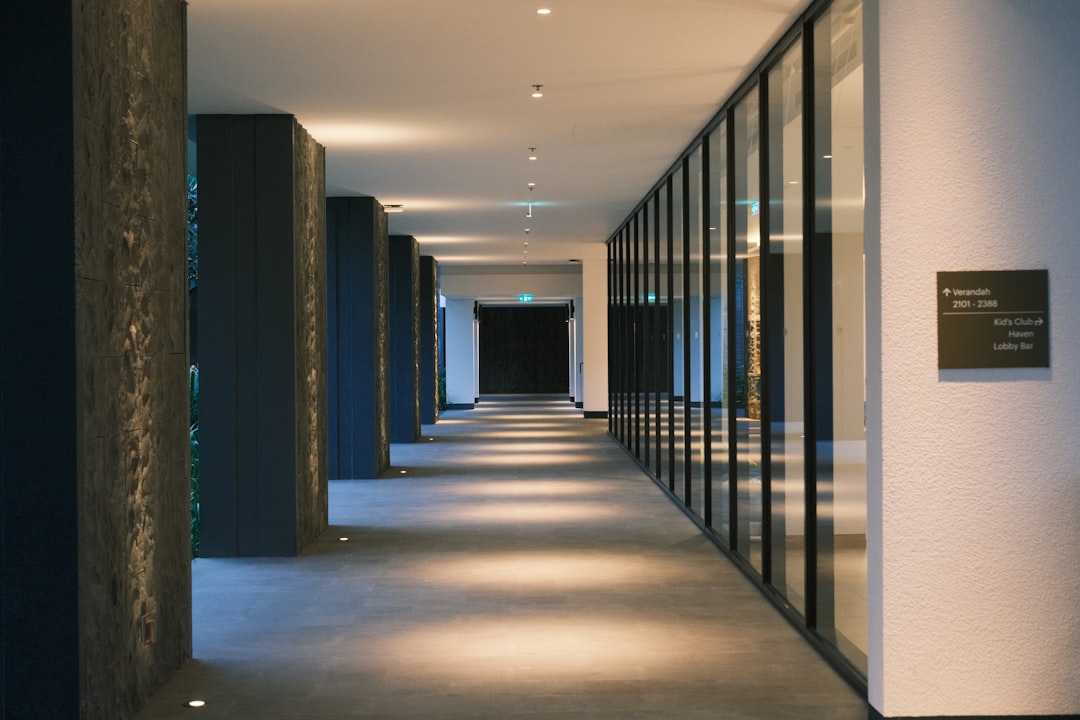Commercial Floors: 2025 Ultimate Guide
Why Commercial Flooring Matters for Your Business Success
Commercial floors are the foundation that shapes every visitor’s first impression of your business. Whether you’re walking into a sleek hotel lobby, a busy retail store, or a professional office space, the flooring sets the tone for the entire experience.
Quick Commercial Flooring Overview:
- Resilient Options: Luxury Vinyl Tile (LVT), Stone Plastic Composite (SPC), and rubber flooring offer durability and water resistance
- Soft Surfaces: Carpet tiles and broadloom provide comfort, noise reduction, and design flexibility
- Hard Surfaces: Porcelain tile, polished concrete, and epoxy coatings deliver maximum durability for high-traffic areas
- Key Factors: Consider traffic levels, moisture exposure, maintenance requirements, and aesthetic goals
- Investment Range: Initial costs vary widely, but proper selection saves money through reduced maintenance and longer lifespan
Unlike residential flooring, commercial floors must withstand heavy foot traffic, frequent spills, and constant use while maintaining their appearance. They need to be tougher, more durable, and often meet specialized requirements like slip resistance or hygiene standards.
The right flooring choice impacts more than just aesthetics. It affects employee productivity, customer perception, maintenance costs, and even indoor air quality. A restaurant kitchen needs water-resistant, easy-to-clean surfaces, while an office space might prioritize noise reduction and comfort.
Modern commercial flooring solutions combine functionality with style. Today’s options offer realistic wood and stone looks in materials that can handle the demands of busy commercial environments – something that wasn’t possible just a few years ago.
I’m Ramy Saber, a Civil Engineer and founder of الأميرة سندريلا A&C, with experience in construction and facility management, including the selection and implementation of commercial floors across various business environments. Through my work in both engineering and digital brand development, I’ve seen how the right flooring choice can transform a space and impact business success.
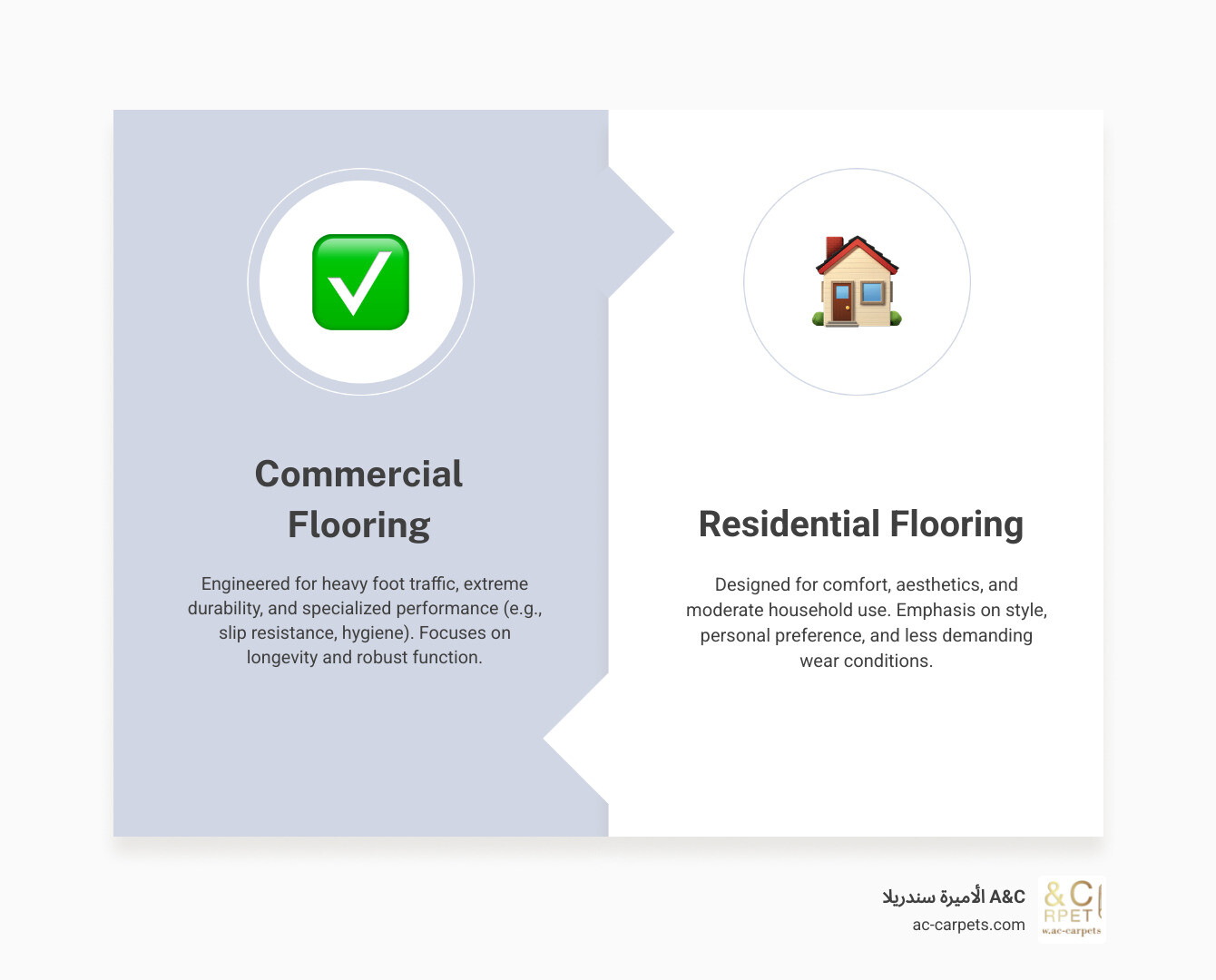
Key Types of Commercial Flooring Solutions
When you step into a busy office building or a busy restaurant, the flooring beneath your feet is working harder than you might imagine. Commercial floors face challenges that would make residential flooring throw in the towel – endless foot traffic, heavy equipment, spills, and the constant demand to look professional day after day.
That’s why commercial flooring comes in three main categories, each designed to tackle specific challenges while keeping your space looking its best.
Resilient Flooring: Vinyl and Rubber
Resilient flooring materials bend without breaking, making them perfect for high-action spaces.
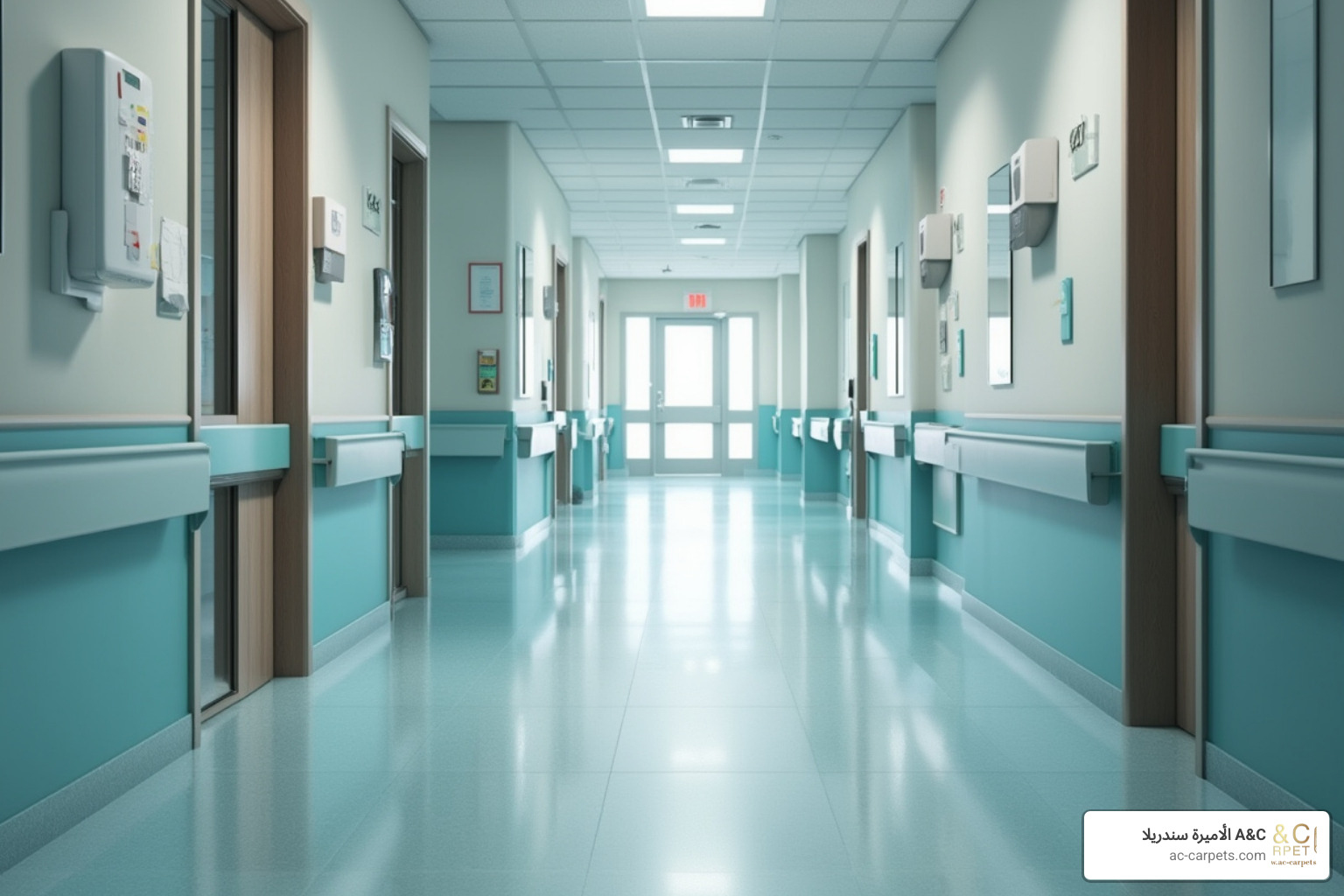
Luxury Vinyl Tile (LVT) and Stone Plastic Composite (SPC) have transformed vinyl flooring. These engineered products have protective layers and realistically mimic wood or stone. Their key commercial benefit is durability. They resist scratches, stains, and water. SPC is 100% waterproof due to its rigid core, ideal for kitchens and healthcare. Easy maintenance is a major advantage; modern LVT and sheet vinyl only need simple daily cleaning, unlike older VCT that required constant stripping and waxing.
Rubber flooring offers unique strengths. It provides excellent noise reduction and anti-fatigue properties, offering natural cushioning that’s easier on joints. Its natural texture also provides superior slip resistance, crucial for safety in hospitals, schools, and wet areas. Rubber excels where safety and comfort are top priorities.
Soft Surface Flooring: Carpet Tiles and Broadloom
Sometimes, commercial floors need to create atmosphere, reduce noise, and add comfort. That’s where carpet comes in, bringing warmth and sophistication to commercial spaces.
Carpet tiles are a highly practical choice. Their modularity is a game-changer for maintenance; damaged tiles can be individually replaced, saving time and money. This also allows for immense design flexibility, letting you create patterns, define zones, or use brand colors. Carpet tiles also provide comfort underfoot, absorb sound for quieter environments, and improve indoor air quality by trapping dust. These benefits are ideal for office environments and hospitality settings.
When selecting carpet for high-traffic areas, look for products with a Texture Appearance Retention Rating (TARR) of 3.5 or higher, as established by the Carpet Rug Institute (CRI) standards. This rating ensures your carpet will maintain its appearance. For more detailed guidance on selecting the right carpet for your needs, check out our comprehensive carpet guide.
Broadloom carpet offers seamless wall-to-wall coverage for a unified, luxurious feel. It’s often used in hotel lobbies and executive offices where visual impact is paramount, though it lacks the easy replacement of tiles.
Hard Surface Flooring: Tile, Concrete, and Epoxy
For the most demanding environments, hard surface commercial floors offer maximum toughness.
Porcelain tile is a champion of durability, with compressive strength rivaling steel and excellent water resistance. It’s perfect for commercial kitchens, retail stores, and entryways. Modern manufacturing allows it to mimic stone or wood, combining performance with aesthetics.
Polished concrete offers a modern, industrial aesthetic for trendy retail stores and offices. Stained concrete adds artistic flair, mimicking high-end materials like marble at a lower cost while retaining concrete’s legendary durability.
Epoxy coatings, applied over concrete, create a seamless surface stronger than the concrete itself, ideal for warehouses, industrial facilities, and anywhere heavy-duty use is the norm. The seamless finish is also hygienic, perfect for food processing facilities and healthcare environments. Epoxy can triple a concrete floor’s lifespan and adds chemical resistance.
Choosing the Right Commercial Floors for Your Space
Picking the perfect commercial floors for your business feels a bit like choosing the right foundation for your home – it needs to support everything that happens above it. The secret isn’t just finding the toughest floor or the prettiest one. It’s about finding the floor that works with your business, not against it.
Matching Flooring to Function: High-Traffic vs. Specific Use Areas
Think about your space for a moment. Where do people naturally gather? Which hallways see a constant stream of foot traffic? These high-energy zones need commercial floors that can handle the pressure.
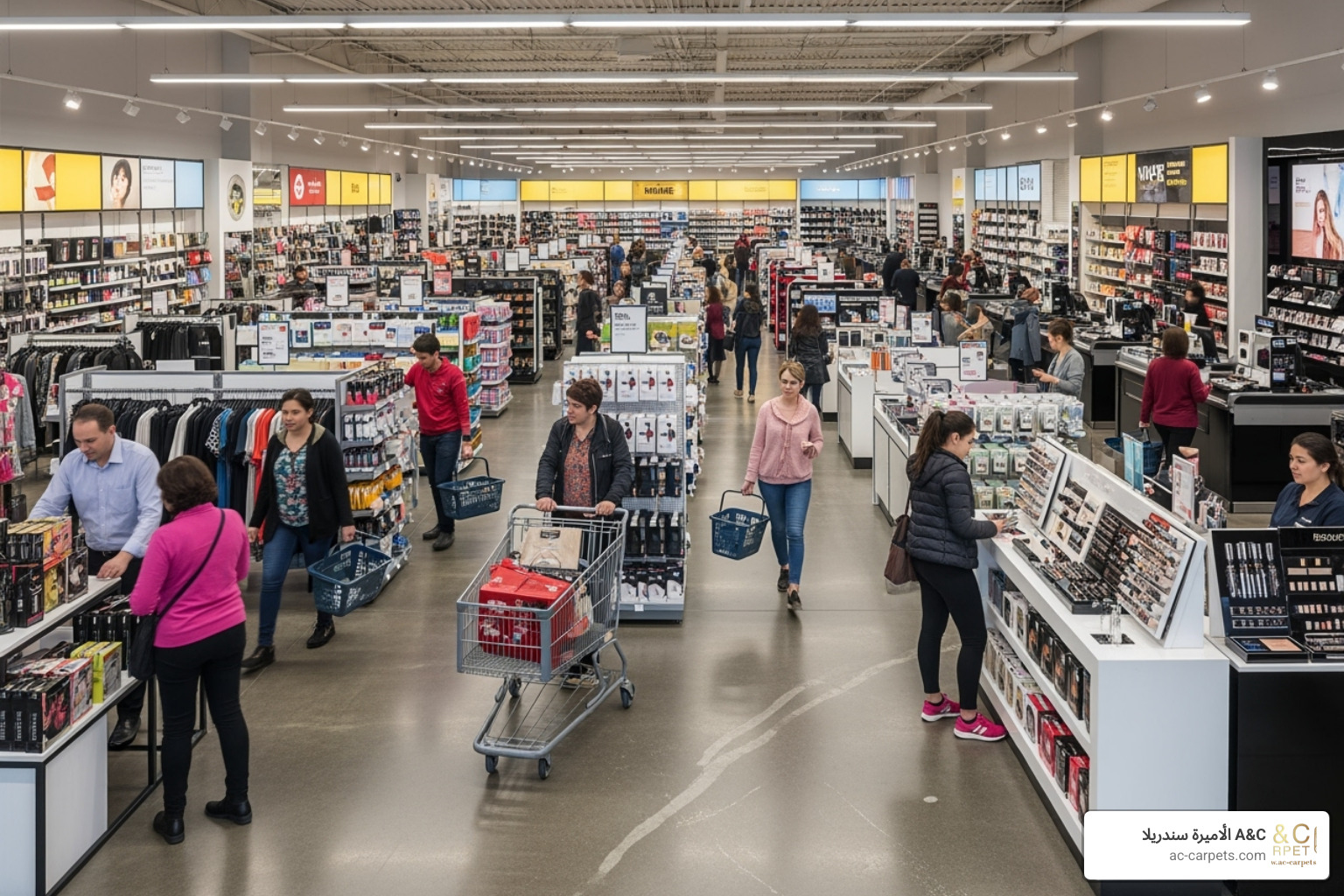
High-traffic areas like lobbies and corridors need floors that can withstand constant use. Technical ratings are key here. For laminate flooring, look for an Abrasion Class (AC) rating of AC4 or AC5. For porcelain tile, a PEI rating of 4 or 5 is best for heavy commercial use. Luxury vinyl flooring (LVT and SPC) is popular for its combination of durability and style, while epoxy coatings are ideal for industrial spaces with heavy machinery.
But not every area faces the same challenges. Specific use areas have unique needs. Moisture-prone areas like kitchens require waterproof options like SPC vinyl or quarry tile. Healthcare facilities and schools need hygienic, seamless surfaces like sheet vinyl or epoxy. Quiet zones like offices and libraries benefit from the sound absorption of carpet tiles or broadloom carpet.
Beyond Durability: Aesthetics, Health, and Productivity
Flooring must be tough, but it also impacts people and perception. Your floor is a canvas for your brand identity. Bold carpet tiles can energize a startup, while polished concrete can signal refinement in a luxury space. Color psychology is also important; warm tones feel welcoming, while cool tones convey professionalism.
Employee wellness is directly linked to flooring. Commercial carpets improve indoor air quality by trapping dust and allergens. For noise reduction, especially in open offices, carpet tiles and rubber flooring absorb sound, boosting focus and productivity. For standing employees, anti-fatigue flooring like rubber provides cushioning that reduces strain, improving comfort and reducing mistakes.
Balancing Budget and Long-Term Value for your commercial floors
The cheapest floor upfront is rarely the best value. Smart budgeting considers the entire lifecycle.
Initial costs for materials and installation expenses are just the start. The true cost is the lifecycle cost, which includes purchase, installation, maintenance, repairs, and replacement. A more expensive floor that lasts longer with less maintenance often provides a better return on investment (ROI).
Maintenance requirements are a major factor. Low-maintenance options like polished concrete and high-quality LVT save significant time and money over floors that need constant waxing or stripping.
Longevity also varies: carpet tiles last 5-10 years (with individual tile replacement), LVT and SPC flooring for 15-25+ years, and quality porcelain tile for 20-50+ years.
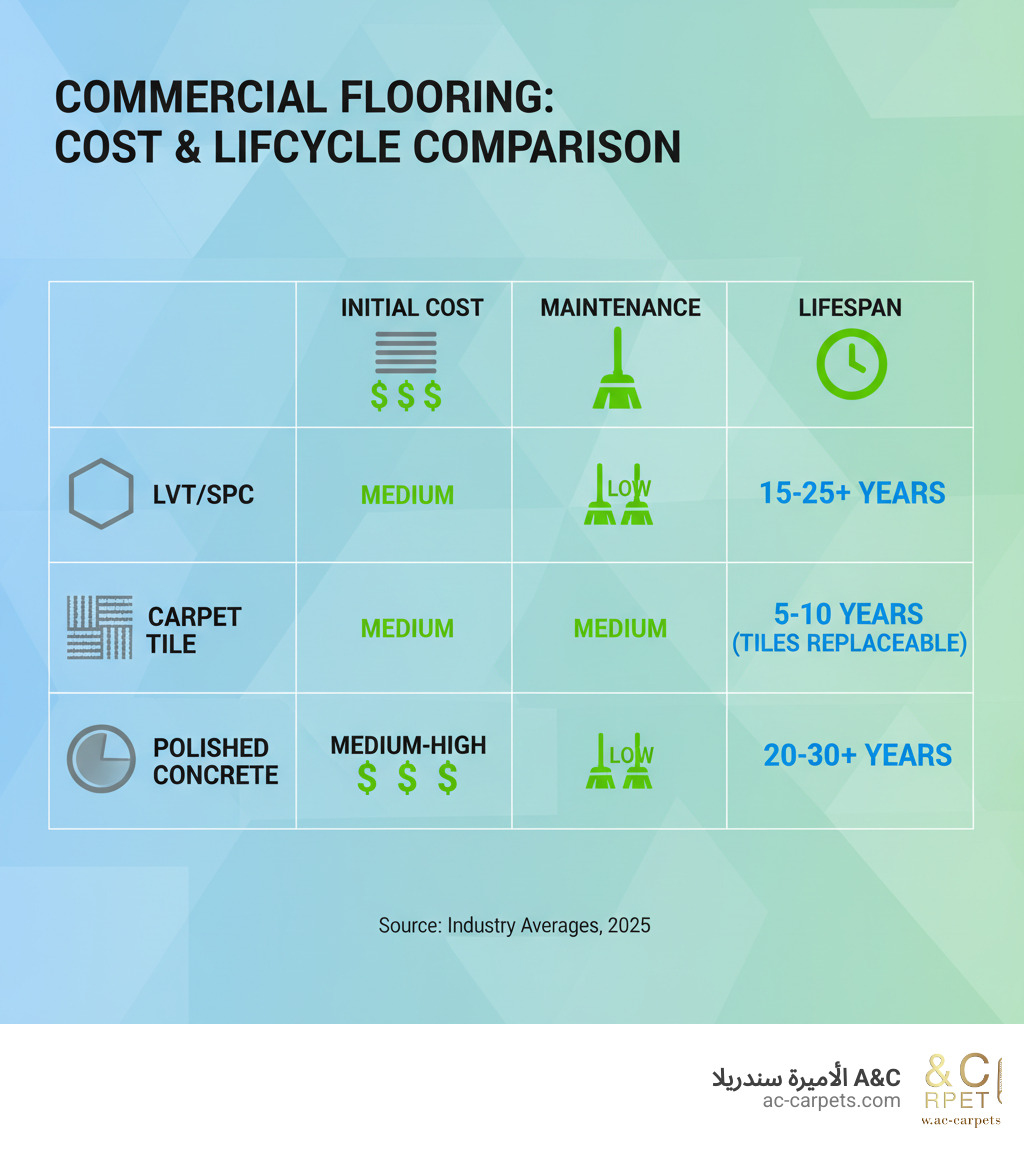
Choosing the right commercial floor is about finding the best long-term value, not just the lowest initial price. A reliable, low-maintenance floor is a business asset that supports your operations instead of creating unexpected costs.
Installation and Maintenance: Protecting Your Investment
Think of your commercial floors as a significant business investment – one that deserves the same careful attention you’d give to any major equipment purchase. The difference between flooring that looks great for decades and flooring that disappoints within a few years often comes down to two critical factors: proper installation and consistent maintenance.
Key Installation Considerations for commercial floors
Getting your commercial floors installed correctly isn’t just about following instructions – it’s about creating the foundation for years of reliable performance. I’ve seen beautiful flooring materials fail prematurely simply because corners were cut during installation.
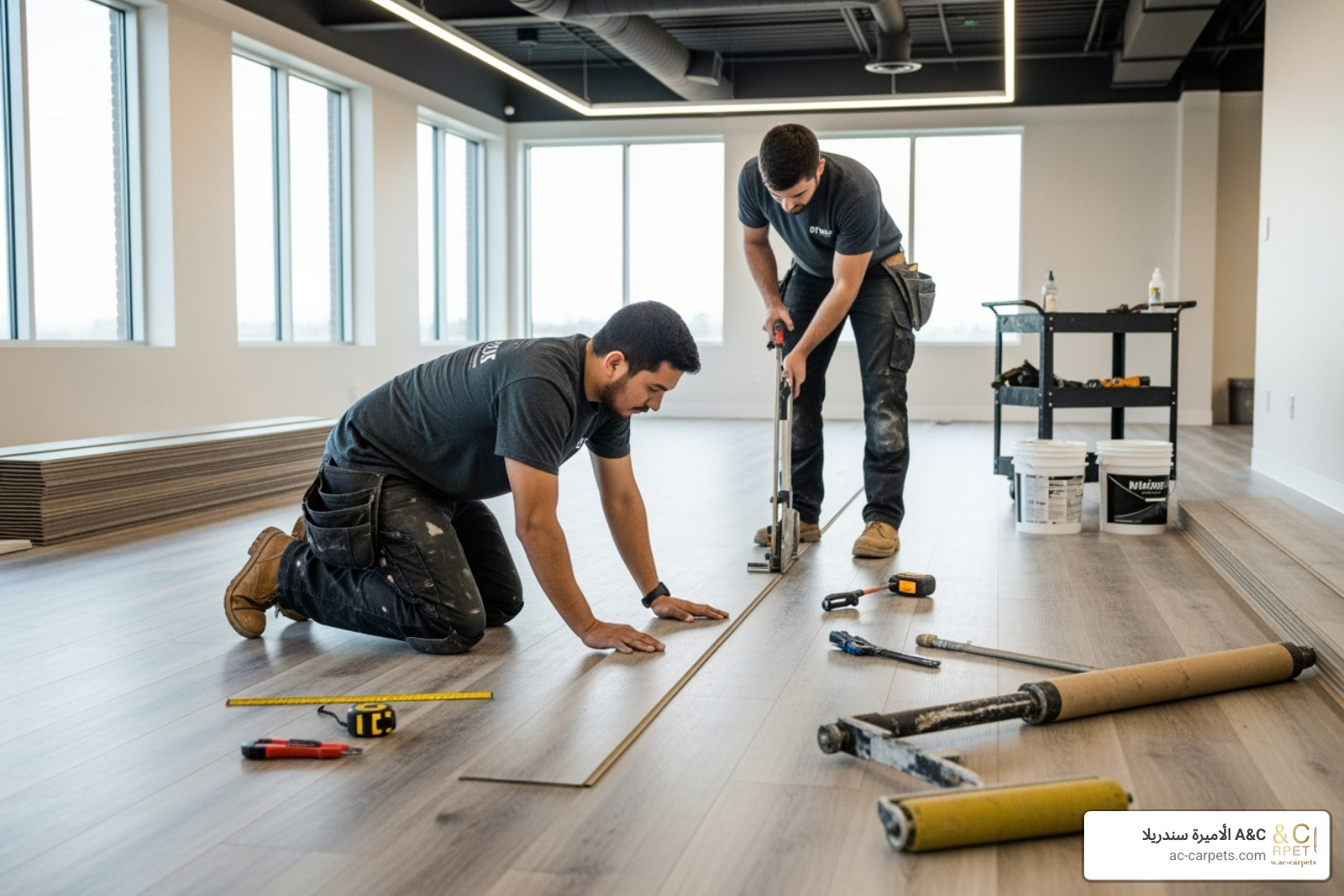
The most important step happens before any flooring even arrives: subfloor preparation. Your new floors are only as good as what’s underneath them. A subfloor that’s uneven, dirty, or damaged will telegraph those problems right through your beautiful new surface. This means taking time to patch holes, grind down high spots, and apply self-leveling compounds where needed.
Moisture testing might seem like an extra step, but it’s absolutely essential. Moisture trapped under flooring can cause warping, bubbling, and adhesive failure – problems that are expensive to fix and impossible to ignore. We always test moisture levels and address any issues before moving forward.
Here’s something that surprises many business owners: commercial floors almost always require professional installation. While you might tackle a home project yourself, commercial materials have specific requirements that trained technicians understand. They know how to handle large format tiles, work with commercial-grade adhesives, and create the seamless finishes that define quality installations.
Most flooring materials need time to acclimatize to your space before installation. This means letting them adjust to the temperature and humidity of your building. Skip this step, and you might find your floors expanding or contracting after installation – creating gaps or buckling that looks unprofessional.
For busy businesses, minimizing downtime during installation is crucial. Professional installers work with you to schedule the project during off-hours, weekends, or in phases that keep your operations running smoothly. Nobody wants customers walking around installation equipment or employees unable to access their workspace.
Essential Maintenance for Longevity
Once your commercial floors are installed, the real work begins – but it’s simpler than you might think. Good maintenance isn’t about expensive equipment or complicated procedures; it’s about consistency and using the right approach for your specific flooring type.
Daily cleaning keeps your floors looking professional and prevents small problems from becoming big ones. For most commercial floors, this means regular sweeping or vacuuming to remove dirt and debris before it gets ground into the surface. Luxury vinyl flooring, for example, stays beautiful with simple daily cleaning using appropriate cleaners.
Deep cleaning schedules vary by material, but they’re essential for every type of commercial flooring. Carpets need periodic hot water extraction, while resilient floors might require specialized scrubbing or buffing. The key is following manufacturer guidelines – using the wrong products or methods can damage your flooring and void your warranty.
When spills happen – and they will – quick stain removal using recommended cleaning agents prevents permanent damage. The faster you act, the better your chances of keeping your floors pristine.
Simple protective measures make a huge difference in your floor’s lifespan. Walk-off mats at entrances dramatically reduce the amount of dirt, moisture, and debris that gets tracked onto your flooring. Furniture pads under heavy items prevent scratches and indentations that can make even new floors look worn.
For businesses with carpet installations, proper care involves regular vacuuming, prompt spot treatment, and scheduled deep cleaning. Our comprehensive carpet care guide provides detailed instructions for keeping carpeted areas looking their best.
The beauty of proper maintenance is that it’s largely preventative. Spend a little time and effort on regular care, and your commercial floors will reward you with years of reliable service and professional appearance. Neglect them, and even the highest-quality materials will show their age prematurely.
Frequently Asked Questions about Commercial Flooring
When businesses start exploring commercial floors, we hear the same thoughtful questions time and again. These concerns are completely understandable – after all, flooring is a significant investment that affects your business for years to come. Let me share the answers to the most common questions we encounter.
What is the most durable type of commercial flooring?
Durability depends on the specific demands of your space. For pure toughness against heavy equipment and chemicals, epoxy coatings are best, creating a surface stronger than the concrete beneath. Porcelain tile is a close second, with incredible compressive strength and resistance to traffic and impact, making it ideal for entryways. Polished concrete is also extremely resilient for high-traffic retail environments. For a blend of durability and comfort, Stone Plastic Composite (SPC) vinyl offers excellent toughness and is 100% waterproof. The most durable floor is the one best matched to your use case.
How often should commercial flooring be replaced?
The lifespan of commercial floors varies significantly by material, which is crucial for budgeting:
- Commercial carpet and carpet tiles: 5-10 years. The modularity of tiles allows for individual replacement, extending the floor’s life.
- Luxury Vinyl Tile and SPC flooring: 15-25+ years with proper care.
- Hard surfaces (porcelain tile, polished concrete, epoxy): 20-50+ years, making them a true long-term investment.
Crucially, maintenance is the single biggest factor in a floor’s longevity. A well-maintained floor can last significantly longer than a neglected one, regardless of the material.
Can I install commercial flooring over an existing floor?
Yes, but only under specific conditions. The existing floor must be perfectly clean, dry, level, and structurally sound, as it will act as the new subfloor. Any imperfections will telegraph through the new flooring.
Floating floors like click-together LVT and SPC products are often suitable for installation over existing hard surfaces. However, the original floor must be well-adhered, with any loose or damaged sections repaired. When installing LVT over existing tile, grout lines must be filled and leveled to prevent them from showing through.
A professional assessment is highly recommended before proceeding. An expert can identify potential issues with moisture or structural integrity that could cause the new installation to fail, saving you significant costs in the long run.
Conclusion
Choosing the right commercial floors is a critical business investment. It’s not just about aesthetics; it’s about finding a solution that improves your space, supports employees, and offers long-term value.
As we’ve seen, modern options offer a solution for every need. Resilient flooring like luxury vinyl provides incredible durability and style, carpet tiles offer comfort and practicality, and hard surfaces like epoxy coatings and polished concrete deliver ultimate strength.
The secret to success is to match the floor to its functionality, balancing aesthetics and budget. Thinking about lifecycle costs, not just the initial price, leads to a smarter investment that saves money on maintenance and replacement down the line.
At الأميرة سندريلا A&C, we understand that every business is unique. We’ve seen how the right flooring can transform a space by improving efficiency, customer perception, and employee satisfaction. Our focus on innovative and modern solutions means we can help you find flooring that’s both practical and stylish for any commercial environment.
The flooring you choose today will be part of your business story for many years. Ready to explore options that combine elegance with practicality? Explore our neat and practical flooring solutions and find how the right foundation can lift your business success.
